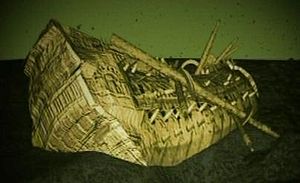London (1656 English ship) facts for kids

The wreck of London
|
|
Quick facts for kids History |
|
|---|---|
| Name | London |
| Ordered | 3 July 1654 |
| Builder | Taylor, Chatham |
| Launched | June 1656 |
| Fate | Accidentally blown up, 7 March 1665 |
| General characteristics | |
| Class and type | 76-gun second-rate ship of the line |
| Tons burthen | 1050 bm |
| Length | 123 ft 6 in (37.6 m) (keel) |
| Beam | 41 ft (12 m) (after girdling) |
| Depth of hold | 16 ft 6 in (5.0 m) |
| Sail plan | Full-rigged ship |
| Complement |
|
| Armament |
|
The London was a powerful warship from the 1600s. It was a 76-gun second-rate ship of the line, meaning it was a large, strong ship built for battle. The ship was part of the English Navy. It was built at Chatham Dockyard and launched in June 1656.
London became famous for helping King Charles II return to England. This event is known as the English Restoration. The ship carried Charles' younger brother, James Duke of York, who later became King James II.
Sadly, the London was destroyed in an accident in 1665. Its powder magazine exploded, causing the ship to sink in the Thames Estuary. Many people on board lost their lives. Today, the wreck is a Protected Wreck site, managed by Historic England.
Contents
The Ship's Early Years and Royal Service
The London was launched from Chatham Dockyard in June 1656. It was first put into service in 1657. Rear-Admiral Richard Stayner was in charge of the ship at first. In 1658, Captain William Whitehorne took command for a short time. Stayner then took command again in 1659.
Bringing the King Back to England
In 1660, a big change happened in England. The king, Charles II, was returning to power after a period of no king. This was called the Restoration. The London was part of the fleet that brought King Charles II back to England.
The royal ships left from Scheveningen in Holland on May 23. They arrived in Dover on May 26. While the king sailed on the main flagship, the London carried his younger brother. This was James, Duke of York, who would later become King James II.
Later Commands and the Final Voyage
From 1660 to 1664, Captain John Lawson was the main commander of the London. After him, Admiral Edward Montagu used the London as his flagship. Captain Jonas Poole directly commanded the ship during this time.
The Tragic Explosion of London
The London was lost on March 7, 1665. It had been briefly given back to Captain John Lawson's command. He was moving the ship from Chatham to the Thames. During this journey, the ship's powder magazine accidentally caught fire.
The explosion caused huge damage. Very little of the ship was left floating on the river. Samuel Pepys, a famous writer of the time, wrote about the sad news. He mentioned that about 24 people and one woman survived. However, over 300 people on board were lost. Captain Lawson was not on the ship, but many of his family members were killed.
What Caused the Explosion?
The exact reason for the explosion is not known. Some people at the time thought it might have been due to cheap or bad quality gunpowder. Another famous writer, John Evelyn, helped care for the survivors. He was a commissioner for sick and wounded sailors.
After the explosion, officials inspected the wreck. They believed the ship's guns could be saved, but the main part of the ship would be lost forever. People continued to try and recover the guns for many years.
Rediscovering the London Wreck
The wreck of the London was found again in 2005. Because of this important discovery, port authorities changed shipping routes. This was done to protect the wreck from further damage. Archaeologists from Wessex Archaeology then began to study the site.
The area where the wreck lies became a protected site in 2008. The London wreck is very important for understanding British naval history. It also gives us clues about life in the 1600s.
Important Discoveries at the Wreck Site
In 2015, a gun carriage was lifted from the seabed near Southend-on-Sea. Historic England described it as being in amazing condition. This find helps us learn more about old naval equipment.
The wreck is still at risk from natural erosion. So, between 2014 and 2016, archaeologists carefully recovered items from the surface. They found about 700 small objects. Almost half of these were made of wood. Reports have been published about these wooden finds and other metal objects.
In September 2019, a German parachute mine from World War II was found and removed from the wreck area.

